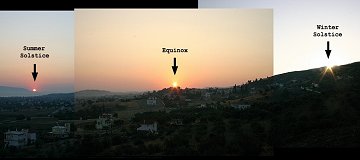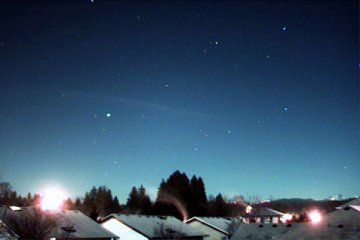 Auroras for Christmas? It could happen... Sign up for SpaceWeather PHONE.
Auroras for Christmas? It could happen... Sign up for SpaceWeather PHONE.
WINTER SOLSTICE: Northern winter begins today, Dec. 21st, at precisely 1835 UT (10:35 am PST) when the sun reaches its lowest declination of the year: minus 23.5o. Get ready for a long night, e.g., 14 hours of darkness in southern California and more than 18 hours in Alaska.
The highest and lowest points in the sky reached by the sun throughout the year are called solstices, and there is a big difference between the summer solstice and its winter counterpart. In Athens, Greece, Anthony Ayiomamitis photographed the sunrise "during summer and winter solstice as well as the intervening equinox."

"[Here in Athens], the azimuth of the rising sun varies by a whopping 66 degrees from one solstice to the other," he marvels.
Meanwhile in the southern hemisphere, today marks the beginning of summer: long days, short nights, and plenty of sunshine. Seasons are opposite on the two ends of our planet. No matter where you live, Happy Solstice!
BLUE SKY AT MIDNIGHT: "Except for the obvious artificial lights, this photo is illuminated completely by moonlight," says Jim Tegerdine of Marysville, Washington "Note the blue color of the sky--even at midnight!"

Tegerdine took the picture on Dec. 15th when the moon was full. To the unaided eye, the sky looked black. But a 15-second exposure with a Meade DSI digital camera revealed the faint blue.
The daytime sky is blue because molecules in the air scatter sunlight--blue more than red. "Moonlight is scattered just like sunlight to produce a blue sky," says atmospheric optics expert Les Cowley. "The darkness of the night sky to our eyes when the moon is up illustrates how weak is the scattering of light by the atmosphere. We need the overpowering brilliance of the sun to generate the soft glow of the daylight sky."

